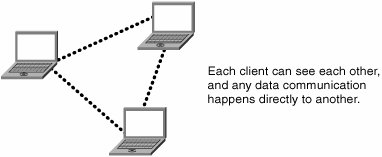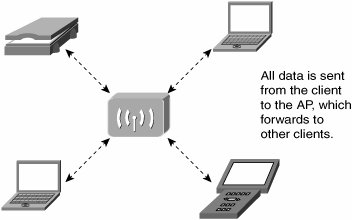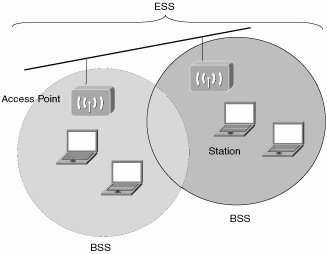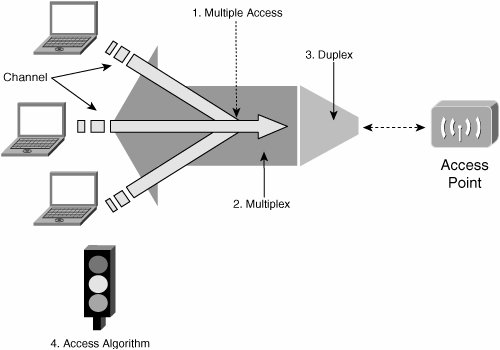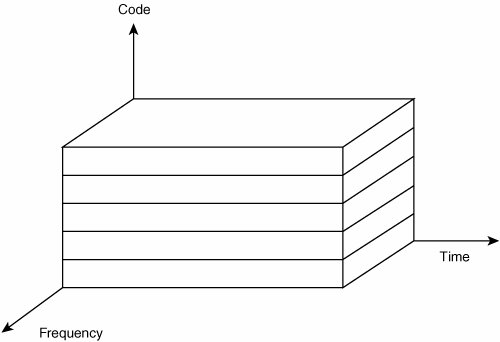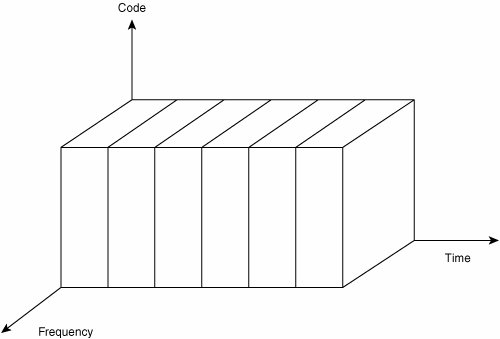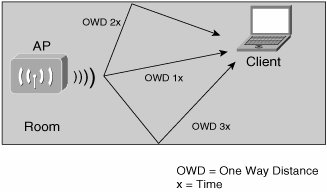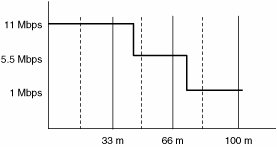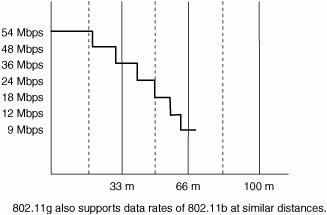How Wireless Networks Function
| Like any other networking technology, a WLAN possesses a number of basic components and characteristics. The most distinctive trait is that WLANs utilize radio channels as the physical transport medium. This same basic radio technology, albeit in different frequency bands, is used by FM radio stations to distribute audio content. The channels are slices of the radio spectrum that a transmitter/receiver uses to send/receive a signal. The fact that radio channels are employed as the transport medium has a specific set of implications. This section discusses not only the components and characteristics, but also the implications of RF as a transport medium. More precisely, you learn about the two different WLAN operating modes: ad-hoc and infrastructure (also known as the base station model). The implications of fading, interference, and noise are touched upon. Furthermore, techniques for efficient use of RF spectrum such as multiplex, duplex, and multiple access technology in addition to the contention resolution mechanisms for acquiring an air channel are covered. Finally, we close the introduction by providing a high-level overview of the differences among current WLAN standards. WLAN ModesWLANs operate in two modes: ad-hoc and infrastructure. The modes define how the stations are related to one another and how orderly communication takes place. The following sections contrast ad-hoc and infrastructure modes in more detail. Ad-Hoc ModeThe ad-hoc WLAN network is an unplanned, unmanaged peer-to-peer relationship. All nodes are equivalents and can directly communicate with other nodes in their vicinity. They do not need to pass through a central point of control. An ad-hoc network thus forms a fully meshed network that uses radio as the interconnection system. The network is a logical mesh. As mentioned earlier, WLANs physically adopt a bus topology with the ether forming the backbone. This mesh should be thought of as a logical communications overlay. Figure 1-8 illustrates this any-toany relationship. The dotted lines depict the virtual interconnections that are created by means of radio links. Figure 1-8. Ad-Hoc WLAN Peer Relationships Even though ad-hoc networks are created on the fly and adopt an any-to-any scheme, they still must share a minimum set of common parameters such as the radio frequency, a common identifier setting, and (if used) a common encryption method. Infrastructure ModeInfrastructure mode is the most common network type used today for enterprise solutions. Fundamentally, this WLAN mode adopts a client/server model. The "clients" are devices with a WLAN interface such as PCs, Personal Digital Assistants (PDAs), wireless IP phones, and many others. The "server" in this case is the AP. Figure 1-9 illustrates the AP client relationship. Figure 1-9. Infrastructure Mode WLAN The logical topology versus physical topology differentiation is the same for ad-hoc mode as for infrastructure mode. Even though Figure 1-9 would lead you to believe that in infrastructure mode, WLAN adopts a star topology, it is in reality a physically collapsed bus topology. This is because the RF medium forms a single Layer 2 collision domain. You can consider it to be equivalent to a traditional coaxial Ethernet network where the electrical wire has been replaced by radio waves. In the perfect environment, every station hears every transmission from every other station. Because both Ethernet (802.3) and WLAN (802.11) use a bus topology, it is not surprising that they use the same technique for determining accessibility to the physical medium. The method employed by these types of networks is carrier sense multiple access (CSMA). There are, however, some subtle differences to medium access control with regard to collision handling because of the RF medium. Collisions occur when two stations inadvertently believe that the medium is available and both start transmitting at the same time. When frames collide, data is lost. Neither frame is successfully received and an orderly retransmit is required. Because there is no supervisory point of control, stations must make up for this by using their own intelligence to secure the medium. Essentially, every station effectively becomes its own traffic cop to manage the orderly access to the physical medium. APs in infrastructure mode form the gateway for the client to the rest of the network. Indeed, all communications must pass through the AP. As such, logical groups of stations are created that share a gateway. This gateway or AP defines a standalone WLAN cell. Note The gateway can be physically implemented by a single or multiple APs. In infrastructure mode, WLANs are comprised of cells. The technical name for a WLAN cell is Basic Service Set (BSS) and has a distinctive identifier known as a Service Set Identifier (SSID). The SSID is the common denominator that logically identifies WLAN cells. It effectively segments the ether through the creation of a virtual Layer 2 network. The WLAN cells can be extended or virtually combined when several BSS cells are in proximity of each other. This is known as an Extended Service Set (ESS). The ESS extends the virtual Layer 2 network by combining multiple BSSs into a singular larger network. Figure 1-10 shows the segmentation into the logical groups of stations that form BSSs. It also illustrates the combination of multiple BSSs that forms an ESS. Figure 1-10. Basic Service Sets (BSS) and Extended Service Sets (ESS) WLAN TechnologiesWhen reviewing the basic setup of a WLAN, several challenges need to be resolved. These include the following:
To obtain a better grasp of the meaning of these various technologies, the analogy of individuals using cars to ship goods through a one-way tunnel is useful:
Figure 1-11 illustrates the relationship between the technologies and where they are relevant within a WLAN. Figure 1-11. WLAN Access Technologies Multiple Access TechnologyIn the context of communications technologies, information can be distributed in both space and time. You can multiplex information using coding, frequency, or time. The respective access methods are as follows:
Multiplex TechnologyTransmitting stations use multiplex technology to merge data onto the air channel. Similar to access technology, multiplexing can be done along code, frequency, and time dimensions. In the case of WLAN technologies, an RF signal is sent using one of three modulation types:
FHSS is an obsolete technology and is not employed in any of today's WLAN implementations. As such, we will look at DSSS and OFDM only. DSSSDSSS is an older and simpler to implementand hence more economical, method for RF modulation. Signals are transmitted on a low-amplitude carrier wave (RF) across a wide band. This is done to combat interference. DSSS defines a channel-to-channel separation of 5 MHz. However, each channel is 22 MHz in width (11 MHz to the left and 11 MHz to the right). Because of this spreading, channels overlap into each other, which inherently causes channel-to-channel interference. There are only three channels in DSSS multiplexing that do not overlap with each other. These are referred to as the transmit or non-overlapping channels and consist of channels 1, 6, and 11. Figure 1-15 represents the 2.4 GHz Industrial, Scientific and Medical (ISM) band. Both IEEE 802.11b and IEEE 802.11g operate in this band, specifically between 2.4 GHz and 2.4835 GHz. Figure 1-15. Industrial, Scientific and Medical (ISM) Band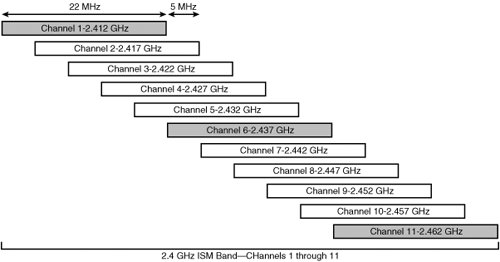 OFDMOFDM is more complex to implement because it uses narrow and precise RF waves. At 20 MHz, the OFDM channel-to-channel separation is wider than that of DSSS modulation at 5-MHz separation. This precise and focused channel spacing is key to the improved data rates that are possible with OFDM multiplexing. To obtain an even higher data rate, each of the eight transmit channels is further divided into 52 subchannels. As a result, there is more surface area to encode data. Figure 1-16 shows the 5-GHz Unlicensed National Information Infrastructure (UNII) band. 802.11a operates in this band, specifically those frequencies between 5.15 GHz and 5.350 GHz. Figure 1-16. Unlicensed National Information Infrastructure (UNII) Band Duplex TechnologyDuplex technology is used to share the same space for an uplink and downlink. Two kinds of duplex technology are relevant to WLANs:
Access TechnologyAccess technology defines which WLAN node can take control of the RF spectrum and how. Although similar to the access method in other IEEE 802 standards, WLANs employ carrier sense multiple access/collision avoidance (CSMA/CA) technology. The defining feature in WLAN is collision avoidance. WLANs use open air, which is borderless, as opposed to other IEEE 802 forms where the transport medium is bounded. In WLANs, detecting whether the medium is busy is nearly impossible. Stations must counter this problem by utilizing acknowledgements to determine when the medium is in use before transmitting their datahence the name collision avoidance. WLAN Radio CommunicationsThis section describes the role and framework of WLAN radio frequencies. WLANs have two specific slices of the RF spectrum: 2.4 GHz and 5 GHz. These frequency bands are unlicensed bands that can be used freely without registration or financial obligation. With their increasing popularity, the use of vast amounts of WLAN devices in these bands has changed access to the airspace from free into a free-for-all. Because the spectrum is unregulated, the possibility of an excessive number of devices in each other's vicinity exists. Indeed, the compounding of the RF interference problem in combination with the massive contention for access to the ether can saturate the frequency range to a point where no successful communication is possible. In this case, the system simply "collapses." This adverse situation must therefore be preempted and addressed. Characteristics That Influence WLAN BandwidthVarious characteristics that are specific to a WLAN can influence the actual throughput that can be achieved. These elements include the modulation technique used, the power of the radio signal, and environmental effects such as attenuation and multipath effects. Each will now be discussed in more detail. ModulationModulation is the process of overlaying a content signal on a carrier signal. The overlaying can be done in terms of amplitude, frequency, or phase. Generally there are three forms of digital modulation:
As a rule, the more complex the algorithm, the higher the data rate. Path Loss, Power, and AntennasIn a perfect environment, the distance that an RF wave will travel is dependent on its frequency and amplitude. However, in a real-world deployment, physical variables such as walls and people have a further impact on path loss. This path loss includes the following:
Power and antenna gain have the most direct effect on signal amplitude. Within the standards for each protocol, as governed by regional regulatory bodies, there are defined limits on the transmit power and antenna use. These limitations directly influence the maximum reach of WLANs. Generally speaking, antenna gain is measured in dBi (isotropic), which is based on a "theoretical antenna." This provides a constant baseline. Note An isotropic antenna is a theoretical concept. If it existed, the signal would radiate in all directions from the antenna, forming a perfect circle. Attenuation, Distortion, and InterferenceAnother important aspect in WLANs is the environment and how it affects radio waves. Because a myriad of environmental elements influence a radio wave, the wave's actual behavior is exceedingly hard to predict deterministically. For example, RF absorption by objects reduces the strength of the signal. In a crowded office, radio transmissions are dampened as they pass through walls, desks, and even people. This is not the case in an open warehouse. Similarly, a functioning microwave oven emits radio waves that might interfere with WLAN signals, especially when in close proximity to any WLAN device. MultipathRadio waves have no boundaries and "bounce" around. This causes an effect known as multipath. The reflection of waves causes them to be received not only multiple times by stations but also at different intervals. Radio receivers need to be able to extract the correct signal from these disparate ones and ferret out the good from the bad. Figure 1-17 illustrates how the ricochet effect of radio waves off objects leads to the multipath effect. Several signals with the same data are sent from the AP into free space, which then "ricochet" in many different directions off different walls (boundaries). The client receives each signal at different times. Figure 1-17. Multipath Effect WLAN device manufacturers integrate specific components into their products to deal with multipath. This is implemented in both hardware and software. Special or customized antennas can also be used to combat the adverse effect of multipath. Directional antennas focus signals and hence counteract the general effects of multipath. Additionally, the radio receiver can accomodate for multipath by reacting to "delay spread" and rejecting duplication of already received signals. Combating External EffectsAll the negative impacts discussed thus far have a direct influence on the relative throughput of a WLAN. For a WLAN to be able to send data, it must accommodate changes incurred from these detrimental factors. To effectively cope with all the adverse external effects, WLANs have adopted a self-throttling throughput strategy. As the strength and quality of a signal diminishes, a WLAN will automatically gear down to adjust to a lower throughput rate. The opposite is also true. As the signal's quality increases, the data rate rises. What we have alluded to is that the defined data rates for each standard actually represent a nominal theoretical boundary. In a perfect scenario, these nominal maxima could be met. However, the reality is that interference, internal radio signaling, antenna type, atmospheric conditions, noise, attenuation, and other influences have a role in determining the real throughput. Actual usable throughput is generally about half of the theoretical rates. For example, in an 802.11b network, the theoretical data rate of 11 Mbps is reduced to an actual usable rate of around 6 Mbps. The same effect of stated to actual data rates applies to 802.11g and 802.11a. No magic formula enables the actual throughput to be predetermined because the factors that influence the real throughput are many and diverse. Regulatory RequirementsAs you have learned, the radio spectrum is at the heart of any wireless network. Because RF devices are used in many critical day-to-day applications, they have become heavily regulated. Police, fire, and air traffic control systems use RF in some form. The regulations are in place to ensure that communications can coexist and occur in a deterministic and orderly fashion. For example, the police can be notified of a bank robbery and airplanes can communicate consistently with air traffic control. Regulations surrounding RF are managed by both national and regional bodies. Significant disparities can exist between respective local regulations. Awareness of potential differences in RF regulations is the first step to complying with them. The second step is knowing which regulatory bodies are relevant in your specific case and where to consult upon them. A sample of the most important regulatory bodies includes
Note Note that this list is far from exhaustive. Contact your local government to assist you in identifying your appropriate regulatory bodies. Each regulatory body defines the specific use or constraint on the use of ISM and UNII radio frequencies. Local authorities define which parts of the spectrum are permitted for use, the power levels that can be emitted by the radio, and allowances surrounding approved commercial and consumer use. Vendors of WLAN devices almost always consider local regulations when developing products. However, WLAN equipment that is compliant for one region does not implicitly translate into compliance for other regions. As such, geographical portability of the WLAN devices is not guaranteed from a regulatory point of view. When planning a WLAN deployment across multiple countries, ensure that the selected equipment has been approved for each location. Additional concerns related to RF are the open availability of the unlicensed bands and their potential overuse. Because these frequency ranges are unlicensed, many devices can coexist and potentially compound interference problems. Different WLAN StandardsThe IEEE 802.11 WLAN standard contains a number of subsets that can potentially lead to confusion. Indeed, the 802.11 substandards have resulted in the creation of an alphabet soup. This section brings order to this situation and expands upon some of the more subtle differences between the various WLAN standards. The IEEE standards that are covered are 802.11b, 802.11g, and 802.11a. Because the respective standards were developed and ratified at different points in time, WLAN equipment manufacturers have also produced hybrid devices that are capable of spanning multiple standards. These are the so-called dual-band devices. 802.11bIEEE 802.11b is the most commonly known WLAN standard. At the time of writing of this book, 802.11b WLANs enjoy the highest market adoption. The standard has three main characteristics:
Because DSSS is a simpler technology to implement in siliconas opposed to softwareit greatly accelerated the 802.11b technology's time to market. However, the simplicity of implementation comes at the cost of efficiency. Early deployments of WLANs were small and primarily used as secondary means for network connectivity. In such an environment, the maximum bandwidth of 11 Mbps was all that was needed, and it served these networks well. The four respective data rates that are employed by 802.11b are 1 Mbps, 2 Mbps, 5.5 Mbps, and 11 Mbps. The effective range goes from 0 to 100 meters. The relationship between nominal throughput and transmission distance is illustrated in Figure 1-18. Figure 1-18. 802.11b Range Versus Throughput 802.11gIEEE 802.11g is a hybrid implementation of WLAN technology. The following are its key characteristics:
The higher data rate and backward compatibility with 802.11b are making IEEE 802.11g the protocol of choice to displace 802.11b. 802.11g operates in the 2.4-GHz frequency range and can employ DSSS, thus facilitating backward compatibility with 802.11b in the lower throughput range. However, 802.11g employs OFDM for data rates above 11 Mbps as opposed to DSSs for data rates below 11 Mbps. OFDM is more efficient than DSSS but also more complex to implement, hence the later time to market and higher initial pricing for 802.11g. Note The frequency band alone does not guarantee compatibility with 802.11b. Other components such as the same modulation and multiplexing techniques are also required for compatibility. For example, 802.11g makes use of DSSS when operating at speeds up to 11 Mbps and switches to OFDM for higher data rates. Every benefit has a consequence, and the same is true for the backward compatibility of 802.11g with 802.11b. A mixed environment results in lower effective data rates for 802.11g because the different multiplexing methods impact the timing of the data transmission and reception. 802.11b packets are sent out with longer interval times as opposed to 802.11g stations. As a result, 802.11g stations throttle down by extending their transmit wait timers so that they do not drown out 802.11b stations. Just like 802.11b, 802.11g is limited by power output constraints, governed by local or regional governments. However, the tighter timing of OFDM enables data rates of up to 54 Mbps in the same frequency band and power level. The 12 respective data rates that are employed by 802.11g are 1 Mbps, 2 Mbps, 5.5 Mbps, 6 Mbps, 9 Mbps, 11 Mbps, 12 Mbps, 18 Mbps, 24 Mbps, 36 Mbps, 48 Mbps, and 54 Mbps. The effective range goes from 0 to 100 meters. The relationship between nominal throughput and transmission distance is illustrated in Figure 1-19. Figure 1-19. 802.11g Range Versus Throughput 802.11aContrary to common belief, the IEEE 802.11a standard is not new to WLAN space, having been ratified in 1999. The three key characteristics of 802.11a are as follows:
Another important aspect of 802.11a is that it has eight non-overlapping channels to transmit on, as opposed to the three in 802.11b/g. This higher number of transmit channels allows for more active sessions. Indeed, the increased number of channels allows more stations to transmit in a given space. This is basically equivalent to adding lanes to a highway. The relationship between nominal throughput and transmission distance for 802.11a is illustrated in Figure 1-20. Figure 1-20. 802.11a Range Versus Throughput The drawback to working in the 5-GHz range is that the radios are more sensitive to environmental conditions. 802.11a has had initial barriers to overcome, namely with price and performance, which probably explain the lower adoption rates. Finally, when you consider that the new 802.11g standard offers comparable speeds and has the significant added benefit of backwards compatibility with 802.11b, it is not surprising that 802.11a faces this higher barrier to entry. Table 1-2 provides a brief summary of the key differences between 802.11a, 802.11b, and 802.11g.
Coexistence802.11a uses a completely different frequency range from 802.11b and 802.11g. If you install 802.11a APs, you must ensure that you have 802.11a clients. In most cases, both infrastructure providers and client radio manufacturers build multiradio products. Both 802.11a and 802.11h use the 5-GHz range and are designed to coexist. 802.11h complements 802.11a so that stations in this band can operate worldwide. If you have an 802.11a network, you don't need 802.11h. Conversely, if you have an 802.11h network, you already have 802.11a without performance or quality issues. Note 802.11h is an IEEE standard that addresses certain power and channel issues that exist in Europe. Additional 802.11 StandardsYou have examined the three LAN standards that define WLANs. However, as the requirements for interoperability, support for regional regulatory requirements, improved security, and other enhancements have evolved, the original IEEE 802.11 working groups have been extended. Many new standards have been defined or are currently under development. This is the cause of much additional confusion. Not only do you need to be familiar with the three WLAN standards (802.11b, 802.11a, and 802.11g), but you also need to deal with an additional raft of new standards. Indeed, more letters have been added to the alphabet soup. It is important to note that the 802.11 standards are constantly evolving. Because the IEEE works through discussion and democratic voting, the process of ratifying a new standard can be lengthy. Many of the current 802.11 standards are therefore still under development. However, this does not stop eager manufacturers from sometimes releasing products that are in a "preratification" state as an attempt to beat their competitors to market. 802.11g is a prime example. Many 802.11g products were released before the standard was put to vote. For the most part, manufacturers will develop their products with the intention of embracing the ratified standard later on. Nevertheless, there are those who will use their current product as a stepping stone for the next standard. We go into further detail in Appendix A, "Wireless LAN Standards Reference." Note As part of the ratification process, no one company or individual is allowed to have an advantage over another. This becomes an additional sticking point and sometimes further bogs down process. |
EAN: 2147483647
Pages: 163
- ERP Systems Impact on Organizations
- Challenging the Unpredictable: Changeable Order Management Systems
- Enterprise Application Integration: New Solutions for a Solved Problem or a Challenging Research Field?
- Distributed Data Warehouse for Geo-spatial Services
- Development of Interactive Web Sites to Enhance Police/Community Relations
